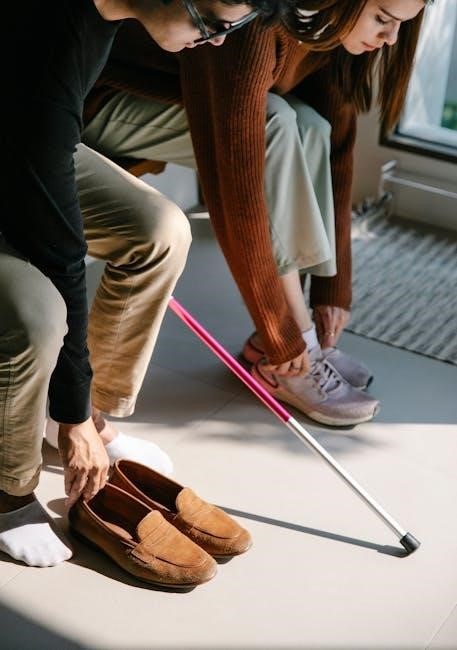Article Plan: A Guide to Getting Rid of Almost Everything
This article outlines a comprehensive plan for decluttering, drawing from various sources and perspectives; It starts by exploring the allure of decluttering and the difficulties encountered when letting go of possessions. It also provides specific strategies and tips for decluttering and simplifying your life.
In today’s consumer-driven society, the concept of decluttering has gained significant traction. The allure of a clutter-free life stems from a desire for simplicity, organization, and a sense of control over one’s environment. Many are drawn to the idea of minimizing possessions, not just for aesthetic reasons, but for the mental and emotional benefits it can bring.
The promise of decluttering is a life with less stress, more freedom, and increased focus on what truly matters. Imagine a home where every item has a purpose, a space that promotes relaxation and productivity. This vision fuels the desire to shed unwanted belongings and embrace a more minimalist lifestyle.
Furthermore, decluttering offers a chance to break free from the cycle of consumerism and re-evaluate our relationship with material possessions. It encourages us to question the value we place on objects and to prioritize experiences and relationships over accumulating more stuff. The initial spark of interest in decluttering often comes from realizing that the accumulation of possessions does not equate to happiness or fulfillment.
The Difficulty of Letting Go

Despite the allure of a clutter-free life, the process of letting go of possessions can be surprisingly difficult. Our belongings often carry sentimental value, representing memories, experiences, and even aspects of our identity. Parting with these items can feel like discarding a piece of ourselves, leading to emotional resistance.
Furthermore, the “sunk cost fallacy” often plays a role in our attachment to things. We may hold onto items simply because we invested time, money, or effort in acquiring them, regardless of their current usefulness or value. This can lead to a sense of obligation to keep things, even if they no longer serve a purpose.

The fear of regret is another significant obstacle. We may worry that we will need an item in the future, or that we will miss it once it is gone. This fear can be amplified by the constant bombardment of advertisements urging us to consume more and more. Overcoming these emotional and psychological barriers is crucial for successful decluttering.
Patricia Marx’s “A Guide to Getting Rid of Almost Everything” (The New Yorker)
Patricia Marx’s “A Guide to Getting Rid of Almost Everything,” published in The New Yorker, offers a humorous yet insightful perspective on the challenges of decluttering. The article acknowledges the inherent difficulty in parting with our possessions, presenting it as a “Dagwood-sized reality sandwich.” Marx explores the emotional attachments we form with our belongings and the various mental gymnastics we employ to justify keeping them.
The guide doesn’t shy away from the practical aspects of decluttering, listing numerous methods for disposing of unwanted items. From donating to selling, Marx covers a range of options, acknowledging that there is no one-size-fits-all solution. The article serves as a valuable resource for anyone struggling with the decluttering process, offering both practical advice and a dose of relatable humor.
It encourages readers to confront their relationship with their possessions and to consider the benefits of a more minimalist lifestyle. While behind a paywall, its insights on decluttering resonate. The article is a worthwhile read.
The Core Principle: Minimalism and Ownership
At the heart of decluttering lies the principle of minimalism, a philosophy that encourages intentional living and the reduction of excess possessions. Minimalism challenges the prevailing consumer culture that often equates happiness with material wealth. It suggests that true contentment can be found not in acquiring more, but in simplifying our lives and focusing on what truly matters.
One approach to minimalism is to limit ownership to a specific number of items, such as 100 possessions, excluding essential clothing, furniture, and personal items. This isn’t a rigid rule, but rather a guideline to encourage mindful consumption and conscious decision-making about what we bring into our lives. It prompts us to question the necessity of each item we own and to consider its impact on our overall well-being.
By embracing minimalism, we can free ourselves from the burden of excessive possessions and create space for experiences, relationships, and personal growth. It’s about owning less and living more.
Decluttering and Western Consumer Culture
Decluttering stands in stark contrast to the pervasive consumer culture that dominates Western societies. This culture thrives on the constant acquisition of goods, often fueled by marketing strategies that equate material possessions with happiness and success. We are bombarded with messages urging us to buy the latest gadgets, fashion trends, and home decor, creating a perpetual cycle of wanting more.
However, this relentless pursuit of material wealth can lead to cluttered homes, overflowing closets, and a sense of dissatisfaction. The more we accumulate, the more we need to manage, clean, and store, which can be a significant source of stress and anxiety. Decluttering offers a way to break free from this cycle by encouraging us to question our consumption habits and to prioritize experiences and relationships over material possessions.
By embracing a minimalist mindset, we can resist the allure of consumerism and create a more intentional and fulfilling life. Decluttering becomes an act of rebellion against a culture that constantly tells us to buy more, allowing us to reclaim our space, time, and peace of mind.
Practical Strategies for Decluttering
Effective decluttering requires a strategic approach; Start by tackling one area at a time, such as a drawer, a shelf, or a corner of a room. Avoid overwhelming yourself by trying to declutter everything at once. As Patricia Marx suggests, it is a long but worthwhile read and it discusses how difficult it is to pitch stuff, but lists tons of ways to do it.
The “four-box method” is a helpful technique: designate boxes for items to keep, donate, sell, or discard. Be honest with yourself about what you truly need and use. If you haven’t used an item in a year, consider letting it go. When deciding what to keep, ask yourself if it brings you joy or serves a practical purpose. If the answer is no, it might be time to say goodbye.
Consider the “one in, one out” rule: for every new item you bring into your home, get rid of something similar. This helps prevent clutter from accumulating. Remember, decluttering is an ongoing process, not a one-time event. Regularly assess your belongings and remove anything that no longer serves you.
Donating Used Books

When decluttering, books often present a unique challenge. Many hold sentimental value, even if they are no longer read. However, letting go of unwanted books can be incredibly rewarding. Donating used books is a fantastic way to give them a new life and support literacy initiatives. Local libraries are often grateful for donations of gently used books, expanding their collections and providing resources for the community.
Schools also frequently accept book donations, particularly those suitable for children and young adults. These donations can enrich classroom libraries and encourage a love of reading. Numerous charitable organizations, such as Goodwill and the Salvation Army, welcome book donations as well. These organizations resell the books to fund their programs and provide affordable reading materials to those in need.
Before donating, ensure the books are in reasonable condition – free from excessive damage or markings. Consider the types of books that are most likely to be accepted by the organization you choose. By donating your used books, you are contributing to a more sustainable and literate society.
Selling Unwanted Items

Decluttering doesn’t always have to mean simply giving things away; Selling unwanted items can be a great way to recoup some of your initial investment and prevent items from ending up in landfills. There are numerous platforms and methods available for selling your belongings, each with its own advantages and disadvantages. Online marketplaces like eBay, Craigslist, and Facebook Marketplace offer a wide reach and allow you to set your own prices.
Consignment shops are another option, where you can drop off your items and receive a percentage of the sale price once they are sold. This can be a convenient option for clothing, accessories, and furniture. Yard sales or garage sales can be effective for selling a larger volume of items quickly, although they require more effort in terms of organization and advertising.
Before selling, take clear and attractive photos of your items and write detailed descriptions. Research similar items to determine a fair price. Be honest about any flaws or imperfections. By carefully considering your options and preparing your items for sale, you can successfully declutter while earning some extra cash.
Revisiting the Guide for Spring Cleaning
As spring cleaning season rolls around, it’s the perfect time to revisit guides that help you declutter and simplify your living space. Patricia Marx’s “A Guide to Getting Rid of Almost Everything” offers a wealth of practical advice and insights that are particularly relevant during this annual ritual of renewal. The guide encourages a thorough assessment of our possessions, prompting us to question the value and purpose of each item we own.
Spring cleaning is more than just tidying up; it’s an opportunity to create a more functional and enjoyable home environment. Marx’s guide provides a framework for making difficult decisions about what to keep, what to donate, and what to discard. It reminds us that decluttering is not just about getting rid of stuff; it’s about creating space for the things that truly matter. By revisiting this guide each spring, we can stay on track with our decluttering goals and maintain a clutter-free lifestyle throughout the year. It emphasizes the importance of continuous evaluation and mindful consumption.
The Benefits of Decluttering: Simplified Living
Decluttering offers a pathway to simplified living, reducing the mental and physical burden associated with excess possessions. By consciously minimizing our belongings, we create space for experiences, relationships, and personal growth. A decluttered environment fosters a sense of calm and clarity, reducing stress and anxiety.
Simplified living extends beyond the physical realm, influencing our mindset and priorities. It encourages mindful consumption, prompting us to question the necessity of each purchase. This shift in perspective can lead to greater financial freedom and a deeper appreciation for the things we already own. Furthermore, decluttering frees up time and energy that can be redirected towards pursuing passions, spending time with loved ones, and engaging in activities that bring us joy. The act of letting go of unnecessary items can be incredibly liberating, allowing us to focus on what truly matters and live a more intentional life. The “spark joy” method can also be beneficial.
Less Maintenance and Easier Cleaning
One of the most tangible benefits of decluttering is the significant reduction in maintenance and cleaning efforts required to keep our living spaces tidy. When we own fewer items, there is simply less to dust, organize, and maintain. This translates into more free time and energy to dedicate to other pursuits.
Imagine a home where surfaces are clear, closets are organized, and drawers are not overflowing. Cleaning becomes a breeze, as there are fewer obstacles to navigate and less clutter to move around. Dusting is quicker, vacuuming is more efficient, and tidying up becomes a manageable task rather than a daunting chore. Moreover, with fewer possessions, it’s easier to keep track of what we own, reducing the likelihood of misplacing items or accumulating duplicates. This streamlined approach to home maintenance not only saves time and effort but also promotes a sense of calm and order in our daily lives. This simplification contributes to a more relaxed and enjoyable home environment.
Decluttering and “Spark Joy” Method
The “Spark Joy” method, popularized by Marie Kondo, offers a unique approach to decluttering that focuses on emotional connection with our belongings. This method encourages us to evaluate each item we own, not based on its practicality or usefulness, but on whether it “sparks joy” within us. If an item elicits a feeling of happiness or contentment, it earns a place in our lives; otherwise, it’s time to let it go.
This approach can be particularly effective for those who struggle with the emotional aspect of decluttering, as it shifts the focus from scarcity and loss to gratitude and joy. By thanking items for their service and bidding them farewell with appreciation, we can minimize feelings of guilt or regret. While some sources suggest that once you’ve thanked items that don’t “spark joy,” you should consider what to do with them. This process helps us curate a collection of possessions that truly resonate with our values and enhance our well-being, creating a home filled with things we love.
Embarking on a journey to declutter and simplify your life is not just about tidying up your physical space; it’s about creating a more intentional and fulfilling existence. By shedding the excess possessions that weigh us down, we free ourselves to focus on what truly matters: experiences, relationships, and personal growth.
The principles and strategies discussed in this guide, from practical disposal methods to mindful evaluation techniques, offer a roadmap for achieving a clutter-free life. It’s important to remember that decluttering is an ongoing process, not a one-time event. Regularly revisiting your belongings and reassessing their value in your life will help you maintain a sense of order and prevent the accumulation of unnecessary items. Embracing minimalism, even partially, allows you to curate your environment to reflect your true values, which cultivates a sense of calm, clarity, and contentment.